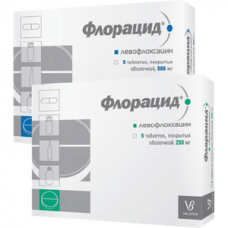Expiration date: 10/2025
The composition and form of issue:
Tablets, film-coated. 1 tablet contains active substance:
levofloxacin (as levofloxacin hemihydrate) 250 or 500 mg
excipients: crospovidone (Kollidon CL) magnesium stearate sodium lauryl sulfate povidone (Kollidon 30) MKC
the composition of the shell: hyprolose (hydroxypropyl cellulose) hydroxypropyl methylcellulose (hypromellose), the colorant iron oxide yellow E172 colorant iron oxide red E172 polyethylene glycol 6000 (macrogol) titanium dioxide E171
in a contour acheikova packing of PVC film and aluminum foil printed patent 5, or 10 PCs. in cardboard pack 1 pack.
Description pharmaceutical form:
Tablets, film-coated pinkish-cream coloured, oblong, biconvex, with valium on one side. In the cross-section are visible two layers.
Pharmacokinetics:
After oral levofloxacin is rapidly and almost completely absorbed from the gastrointestinal tract. Food intake has little effect on the speed and completeness of absorption. Biodostupnostthew 500 mg of levofloxacin is 100%. At a dose of 500 mg of levofloxacin Cmax in plasma is 5, 2-6, 9 µg/ml, Tmax — 1, 3 h, T1/2 6-8 hours
Connection with the plasma protein — 30-40%. Well into the organs and tissues: lungs, mucous membranes, bronchi, sputum, urinary tract, bone, cerebrospinal fluid, prostate gland, polymorphonuclear leukocytes, alveolar macrophages.
In the liver, a small part is oxidized and/or deacetylated.
Excreted mainly by the kidneys by glomerular filtration and tubular secretion. About 87% of the dose appears kidneys in an unmodified form within 48 h, less than 4% is excreted through the intestine within 72 hours
Description pharmacological action:
Antimicrobial broad-spectrum drug from the group fluoroquinolones, levo isomer of ofloxacin. Levofloxacin does DNK-girazu (topoisomerase II) and topoisomerase IV, violates supercoiling and cross-linking of DNA breaks, inhibits DNA synthesis, causes profound morphological changes in cytoplasm, cell wall and membranes.
Levofloxacin is active against most strains of microorganisms both in vitro and in vivo.
In vivo effective against Enterococcus faecalis, Staphylococcus aureus, Staphylococcus epidermidis, Streptococcus pneumoniae, Streptococcus pyogenes and Streptococcus agalactiae, Viridans group streptococci, Enterobacter cloacae, Enterobacter aerogenes, Enterobacter agglomerans, Enterobacter sakazakii, Escherichia coli, Haemophilus influenzae, Haemophilus parainfluenzae, Klebsiella pneumoniae, Klebsiella oxytoca, Legionella pneumoniae, Moraxella catarrhalis, Proteus mirabilis, Pseudomonas aeruginosa, Pseudomonas fluorescens, Chlamydia pneumoniae, Mycoplasma pneumoniae, Acinetobacter anitratus, Acinetobacter baumannii, Acinetobacter calcoaceticus, Bordetella pertussis, Citrobacter diversus, Citrobacter freundii, Morganella morganii, Proteus vulgaris, Providencia rettgeri, Providencia stuartii, Serratia marcescens, Clostridium perfringens.
In vitro:
Sensitive microorganisms (IPC &le2 mg/ml):
Aerobic gram-positive microorganisms: Corynebacterium diphtheriae, Enterococcus spp., Listeria monocytogenes, Staphylococcus spp. (coagulasenegative methicillin-sensitive/methicillin-resistant-moderately susceptible strains), Staphylococcus spp. (CNS), Streptococcus spp. group C and G.
Aerobic gram-negative microorganisms: Acinetobacter spp. Actinobacillus actinomycetemcomitans, Eikenella corrodens, Enterobacter spp., Gardnerella vaginalis, Haemophilus ducreyi, Helicobacter pylori, Klebsiella spp., Neisseria gonorrhoeae (strains producing and reproducirse penicillinase), Neisseria meningitidis, Pasteurella spp. (including conis Pasteurella, Pasteurella dagmatis, Pasteurella multocida), Providencia spp., Pseudomonas spp. Salmonella spp., Serratia spp.
Anaerobic microorganisms: Bacteroides fragilis, Bifidobacterium spp., Fusobacterium spp., Peptostreptococcus spp., Propionibacterum spp. Veilonella spp.
Other microorganisms: Bartonella spp. Chlamydia psittaci, Chlamydia trachomatis, Legionella spp., Mycobacterium spp. (including Mycobacterium leprae, Micobacterium tuberculosis), Mycoplasma hominis, Rickettsia spp. Ureaplasma urealyticum.
Levofloxacin are moderately active (IPC &ge4 mg/l):
Aerobic gram-positive microorganisms: Corynebacterium urealiticum, Corynebacterium xerosis, Enterococcus faecium, Staphylococcus epidermidis (methicillin-resistant strains), Staphylococcus haemolyticus (methicillin-resistant strains).
Aerobic gram-negative organisms: Burkholderia cepacia, Campilobacter jejuni, Campilobacter coli.
Anaerobic microorganisms: Bacteroides thetaiotaomicron, Bacteroides vulgatus, Bacteroides ovaius, Prevotella spp., Porphyromonas spp.
Resistant to levofloxacin (IPC &ge8 mg/l):
Aerobic gram-positive microorganisms: Corynebacterium jeikeium, Staphylococcus aureus (methicillin-resistant strains), Staphylococcus spp. (coagulasenegative methicillin-resistant strains).
Aerobic gram-negative microorganisms: Alcaligenes xylosoxidans.
Other microorganisms: Mycobacterium avium.
Indications:
Infectious-inflammatory diseases caused by sensitive microorganisms:
- acute sinusitis
- exacerbation of chronic bronchitis
- community-acquired pneumonia
- complicated infections of the kidneys and mochevyvodjashchih ways (including a pyelonephritis)
- uncomplicated urinary tract infection
- bacterial prostatitis
- infection of the skin and soft tissues
- intra-abdominal infection
- comprehensive treatment of drug-resistant forms of tuberculosis.
Contraindications:
- hypersensitivity to levofloxacin or to other hinolonam
- epilepsy
- lesions of the tendons at the earlier treatment quinolones
- childhood and adolescence (up to 18 years)
- pregnancy and lactation.
With caution: in elderly age with a high probability of having a concomitant decrease in renal function, with a deficit glukozo-6-fosfatdegidrogenaza.
Side effects:
Side effects, depending on the frequency of their occurrence: often from 1-10 patients out of 100 and sometimes less than 1 patient out of 100 is rare — less than 1 patient out of 1000 very rare — less than 1 patient out of 10,000 in some cases — less than 0, 01%.
Allergic reactions: sometimes — itching and redness of the skin rare — urticaria, bronchospasm, asphyxia, very rare — swelling of skin and mucous membranes (for example, in the facial area and throat), anaphylactic shock, allergic pneumonitis, vasculitis in some cases — Stevens-Johnson syndrome, toxic epidermal necrolysis (Lyell's syndrome) and exudative erythema multiforme.
From the digestive system: often — nausea, diarrhea, increased ALT activity, ACT and sometimes loss of appetite, vomiting, abdominal pain, dyspepsia rare — increased levels of bilirubin in the blood, diarrhea with blood (in very rare cases, it may be a sign of intestinal inflammation and pseudomembranous colitis), goiter, very rare — hepatitis.
From the metabolic: very rarely — hypoglycemia (manifested by a sharp increase in appetite, nervousness, sweating, trembling). The use of other quinolones suggests that they can cause exacerbation of porphyria, in some cases, this effect is not excluded when using levofloxacin.
CNS and peripheral nervous system: sometimes — headache, dizziness and/or numbness, drowsiness, sleep disturbances rare depression, anxiety, psychotic reactions (with e.g. hallucinations), paresthesia in the hands, tremors, restlessness, convulsions and confusion very rare visual disturbances and hearing, disorders of taste and smell sensitivity, reduction of tactile sensitivity.
From the CCC: rarely — tachycardia, decrease in blood pressure very rarely circulatory collapse in some cases — prolonged QT interval.
From the side of musculoskeletal system: rare — lesions tendonitis (including tendonitis), joint and muscle pain is very rare — tendon rupture (e.g. Achilles tendon can be observed within 48 h after the start of treatment and to wear bilateral in nature), arthralgia, myalgia, muscle weakness, of particular importance for patients with bulbar syndrome and in some cases — muscle damage (rhabdomyolysis).
From the urinary system: rarely — increased creatinine in the serum is very rarely — a violation renal function, up to acute renal failure, interstitial nephritis.
On the part of the blood: sometimes — eosinophilia, leukopenia, rarely — neutropenia, thrombocytopenia, hemorrhage very rarely — agranulocytosis in isolated cases — haemolytic anaemia, pancytopenia.
Other: sometimes — asthenia very rare — development of superinfection, fever, photosensitization.
Drug interactions:
Chinolone can enhance the ability of the drugs (including NSAIDs, theophylline) to lowering the threshold of convulsive readiness. Action of levofloxacin is significantly reduced when the simultaneous administration with sucralfate, magnesium or aluminum-containing antacids and iron salts (the interval between administration of levofloxacin and these drugs should be at least 2 hours). With calcium carbonate interactions have been identified.
The elimination (renal clearance) of levofloxacin is slightly retarded by the action of cimetidine and probenecid, which has virtually no clinical significance.
Levofloxacin increases T1/2 of cyclosporine from blood plasma.
Concomitant use of corticosteroids increases the risk of tendon rupture.
Method of application and dose:
Inside, with liquid squeezed enough liquid (from 0, 5 to 1 Cup), can be taken before meals or between meals. Doses are determined by the nature and severity of the infection, and the alleged sensitivity of the pathogen.
Patients with normal or moderately reduced renal function (creatinine Cl >50 ml/min) recommended dosage regimen of the drug:
Sinusitis: 500 mg 1 time a day for 10-14 days.
Exacerbation of chronic bronchitis: 250 or 500 mg 1 time a day for 7-10 days.
Community-acquired pneumonia: 500 mg 1-2 times a day 7-14 days.
Uncomplicated urinary tract infections: 250 mg 1 time per day — 3 days.
Prostatitis: 500 mg 1 time a day for 28 days.
Complicated urinary tract infections including pyelonephritis: 250 mg 1 time a day for 7-10 days.
Infections of skin and soft tissues: 250 mg 1 time per day or 500 mg 1-2 times a day 7-14 days.
Intra-abdominal infection: 500 mg 1 time per day for 7-14 days (in combination with antibacterial drugs acting on the anaerobic flora).
Comprehensive treatment of drug-resistant tuberculosis: 500 mg 1-2 times a day. Duration of treatment — up to 3 months.
The dosage in patients with impaired renal function
| Creatinine Cl, ml/min | 250 mg/24 h | 500 mg/24 h | 500 mg/12 h |
| First dose: 250 mg | First dose: 500 mg | First dose: 500 mg | |
| 50–20 | Then: 125 mg/24 h | Then: 250 mg/24 h | Then: 250 mg/12 h |
| 19–10 | Then: 125 mg/48 h | Then: 125 mg/24 h | Then: 125 mg/12 h |
| <10 (including hemodialysis and papd) | Then: 125 mg/48 h | Then: 125 mg/24 h | Then: 125 mg/24 h |
Papd — continuous ambulatory peritoneal dialysis.
After hemodialysis or continuous ambulatory peritoneal dialysis does not require the introduction of additional doses.
When the liver does not require special selection of doses, as levofloxacin is metabolized in the liver only in a very small degree.
For elderly patients not required a change in dosing regimen, with the exception of cases of low creatinine clearance.
As with other antibiotics, treatment with Floracid is recommended to continue for at least 48-72 hours after normalization of body temperature or after reliable eradication of the pathogen.
If you skipped a dose, you should as soon as possible to start taking and continue to take Floracid for a suggested scheme.
Overdose:
Symptoms: sputannosti consciousness, dizziness, impairment of consciousness and convulsive seizures by type of epiperipatus, nausea, vomiting, erosive lesions of the mucous membranes, prolongation of the QT interval.
Treatment: symptomatic. Levofloxacin is not displayed by dialysis. There is no specific antidote.
Special instructions:
In the appointment of Floracid elderly patients should be borne in mind that patients in this group often have renal dysfunction.
In case of severe pneumonia caused by pneumococcus, Floracid may not be sufficiently effective. Hospital infections caused by Pseudomonas aeruginosa may require combined treatment.
During treatment with the drug Floracid may develop an attack of convulsions in patients with previous brain damage due, for instance, by stroke or severe trauma.
Despite the fact that the photosensitivity observed in the application of the drug Floracid very rarely, to avoid the development of patients should avoid exposure to the sun or ultraviolet radiation.
If you suspect pseudomembranous colitis should immediately stop Floracid and begin appropriate treatment. In such cases it is impossible to use drugs that suppress intestinal motility.
The elderly patients when using the drug Floracid the likelihood of developing tendinitis increases. With the use of corticosteroids increases the risk of tendon rupture. If you suspect tendonitis, you should immediately cancel Floracid and start appropriate treatment, providing a state of peace in the affected area.
While using vitamin K antagonists is necessary to monitor the blood coagulation system.
In patients with deficiency of glucose-6-phosphate dehydrogenase possible hemolysis.
Effects on ability to drive and operate machinery
During the period of treatment must be careful when driving and occupation of other potentially hazardous activities, require high concentration and psychomotor speed reactions.


